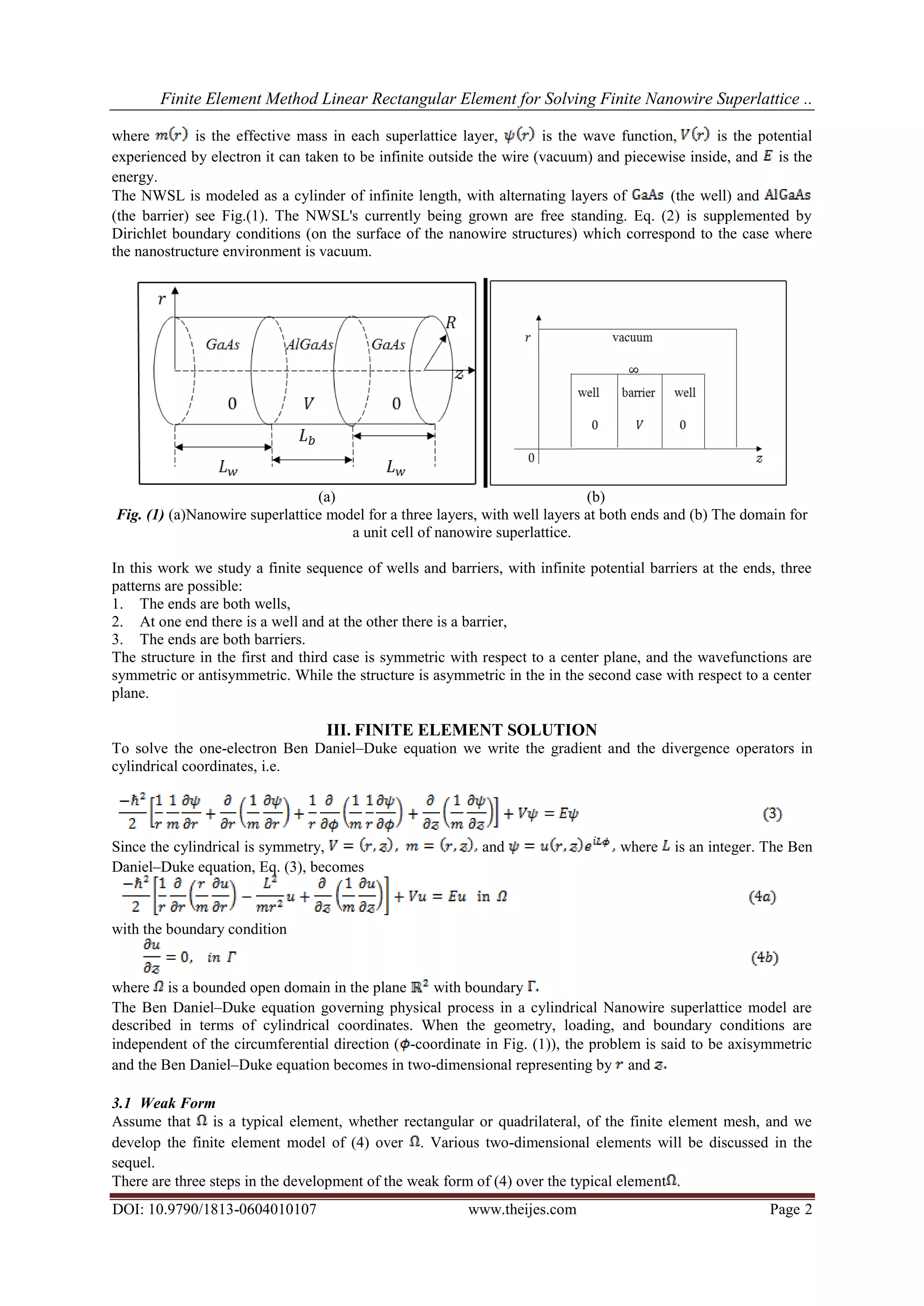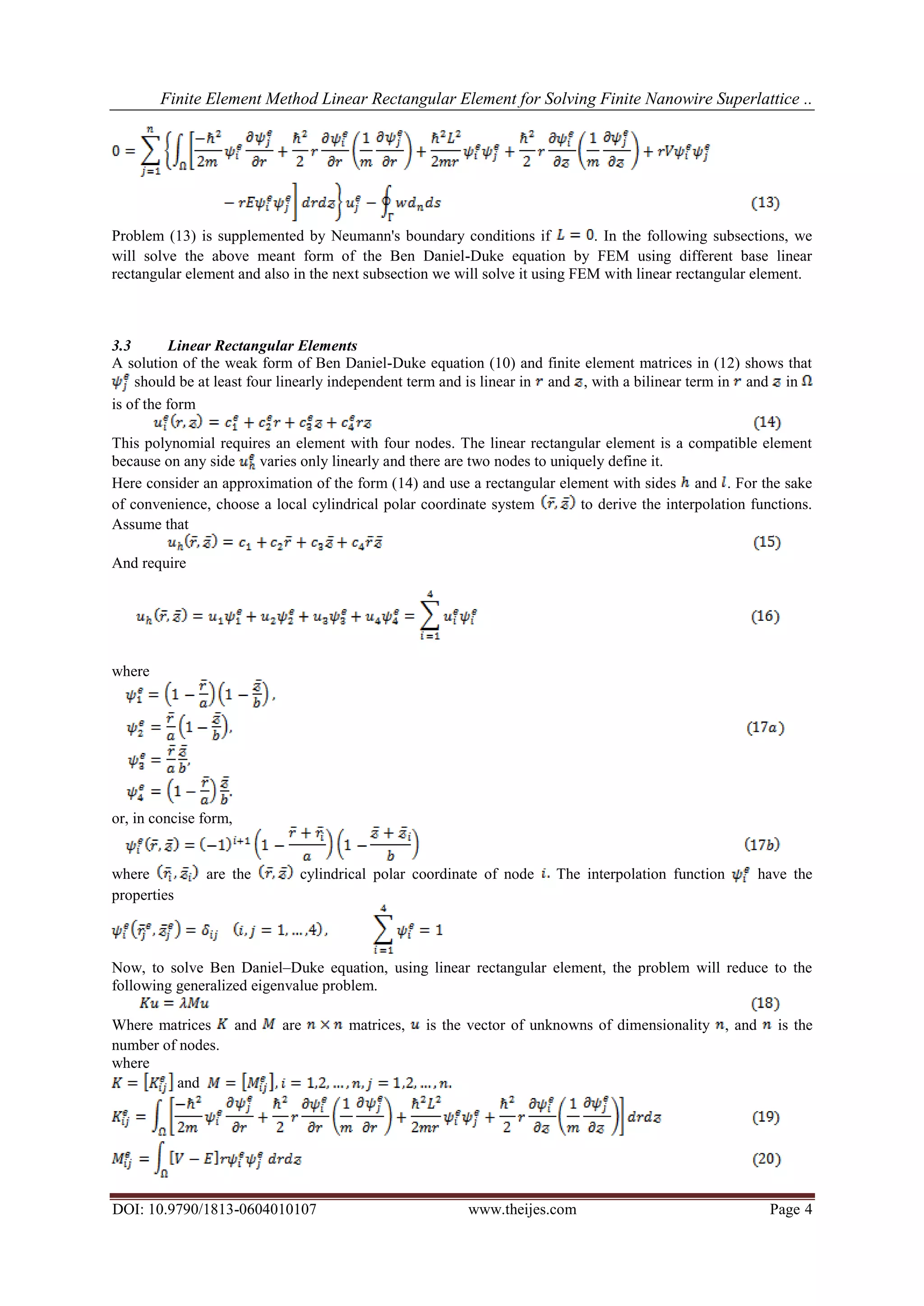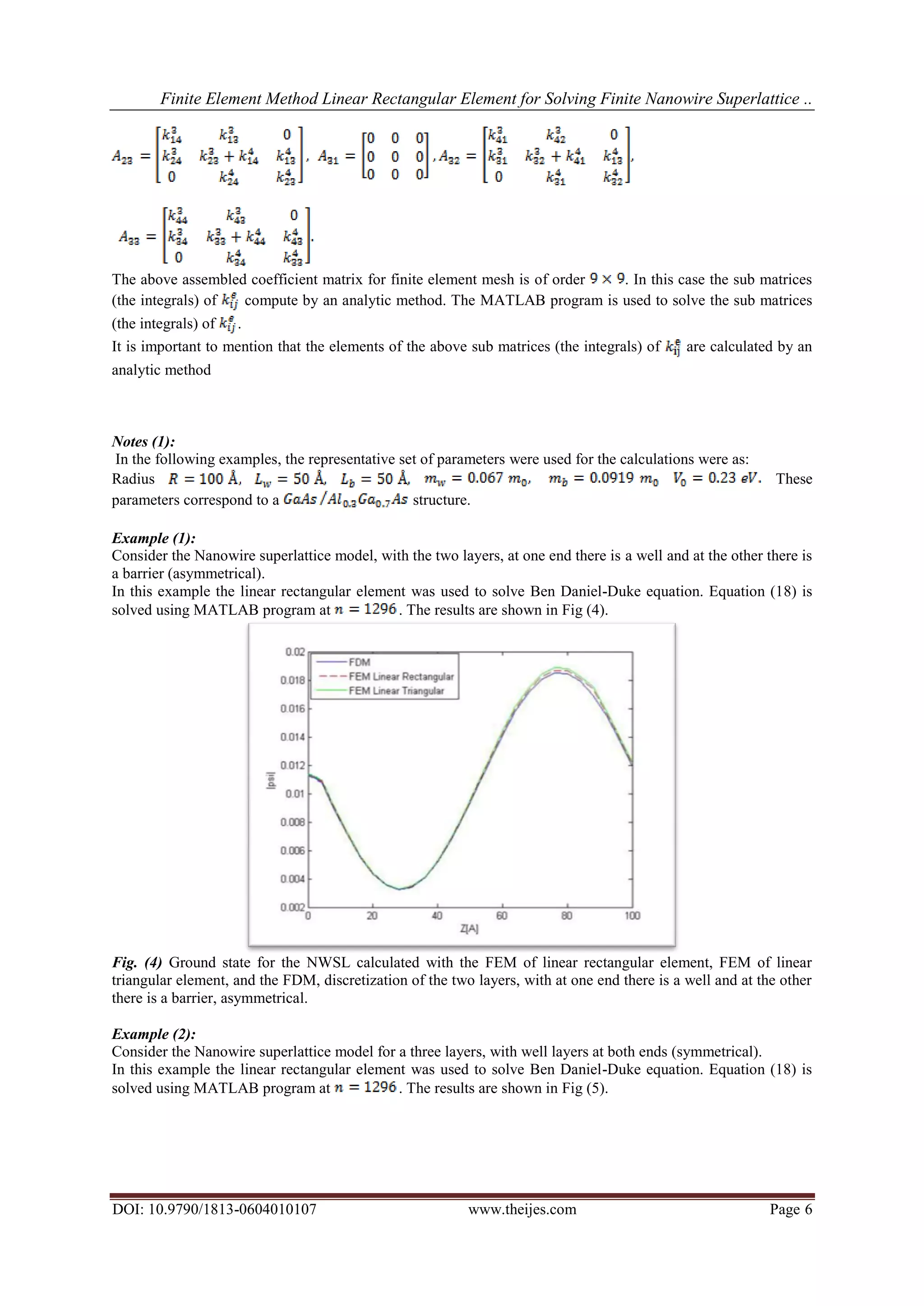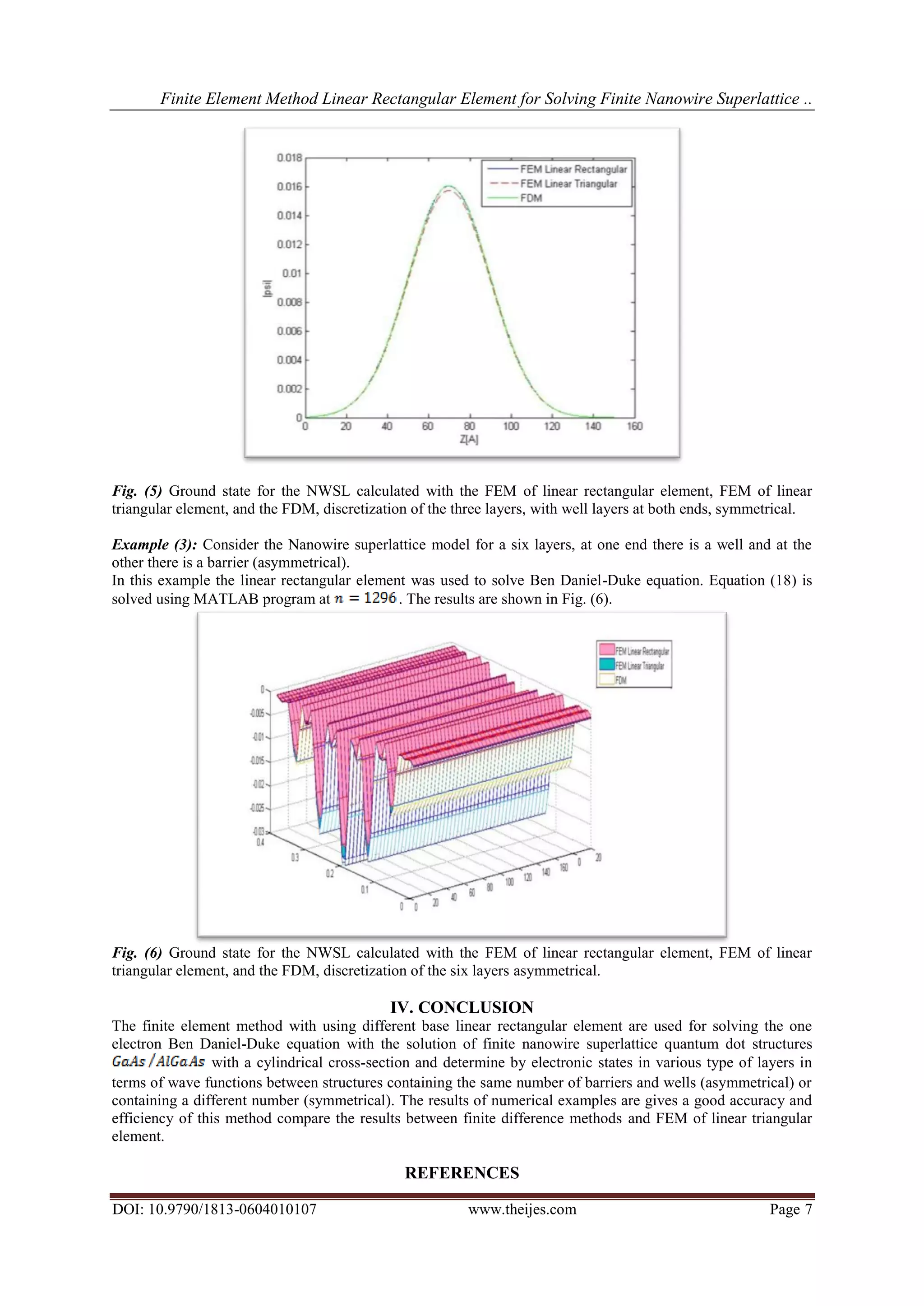This paper presents a finite element method using linear rectangular elements to solve the one-electron Ben Daniel-Duke equation for finite nanowire superlattice quantum dot structures with cylindrical cross-sections. Various structures are analyzed, comparing numerical results for accuracy and efficiency against finite difference methods. The findings indicate that the proposed method yields good results across different configurations, demonstrating the effectiveness of this approach in modeling semiconductor nanostructures.
![The International Journal of Engineering and Science (IJES)
|| Volume || 6 || Issue || 4 || Pages || PP 01-07 || 2017 ||
ISSN (e): 2319 – 1813 ISSN (p): 2319 – 1805
DOI: 10.9790/1813-0604010107 www.theijes.com Page 1
Finite Element Method Linear Rectangular Element for Solving
Finite Nanowire Superlattice Quantum Dot Structures
1
Eman Ali Hussain, 2
Jamil A. Al-Hawasy and 3
Lamyaa H. Ali
1
Asst.Prof., Dr., Department of Mathematics, college of Science, University of AL-Mustansiriyah, Iraq
2
Asst.Prof., Dr., Department of Mathematics, college of Science, University of AL-Mustansiriyah, Iraq
3
Lec., Department of Mathematics, college of Science, University of AL-Mustansiriyah, Iraq
--------------------------------------------------------ABSTRACT-----------------------------------------------------------
This paper concerned with the solution of finite nanowire superlattice quantum dot structures
with a cylindrical cross-section determine by electronic states in various type of layers in terms of wave
functions between structures containing the same number of barriers and wells (asymmetrical) or containing a
different number (symmetrical). The solution is considered with the Finite element method with different base
linear rectangular element to solve the one electron Ben Daniel-Duke equation. The results of numerical
examples are compared for accuracy and efficiency with the finite difference method of this method and finite
element method of linear triangular element. This comparison shows that good results of numerical examples.
---------------------------------------------------------------------------------------------------------------------------
Date of Submission: 17 February 2017 Date of Accepted: 07 April 2017
---------------------------------------------------------------------------------------------------------------------------
I. INTRODUCTION
The modeling of the electron states in semiconductor nanostructures remains a difficult computational task.
In 1966, Ben Daniel and Duke, [1] are used space-charge effects on electron tunneling of the one electron model
is formulated to describe Ben Daniel-Duke equation. There are various methods to solve this type of problems
such as in 1988 Ghatak et. al., [2] used transfer matrix method. In 1990, Paasch et. al., [3] used envelope
equation and wave function matching for narrow-gap semiconductors. In 1995, Mathine et. al., [4] applied
computational Fourier series solution of the BenDaniel-Duke Hamiltonian for arbitrary shaped quantum wells.
In 2003, Melnik et al, [5] applied finite element analysis of Nanowire superlattice structures. Whereas 2004,
Melnik et al, [6] using finite difference method in cylindrical polar coordinates Nanowire superlattice. In 2016,
Deyasi et. al., [7] applied numerically computed in presence of electric field using propagation matrix method.
In this paper we propose a Finite element method and using different base linear rectangular element for solving
Ben Daniel-Duke equation. This solution is considered with the solution of finite nanowire superlattice quantum
dot structures of a cylindrical cross-section and determine by electronic state in the two of
layers (the well) and (the barrier), three of layers with well layers at both ends and six of layers
with well layers at one end and barrier layers at the other end, in terms of wave functions, between structures
containing the same number of barriers and wells (asymmetrical) and structures where the number of barrier
layers is one above the number of well layers (symmetrical).
II. DESCRIPTION OF THE BEN DANIEL-DUKE EQUATION[5],[6]
The Nanowire superlattice (NWSL) is modeled as an ideal cylinder with sharp modulations in the longitudinal
(or -direction). The theory of the electron state used here is the one-band envelope function theory. In the
application, the effective mass of the electron is dependent on the position, but does not depend on energy. The
electronic structure can be found in general based on a multiband model for the envelope function:
where is the Hamiltonian, is called eigenfunction, and is called energy eigenvalue.
Quantum mechanical problems in semiconductor heterostructures are often treated using a single band effective
mass equivalent Hamiltonian. This means in a more general that only envelope functions as solutions of the
equivalent Ben Daniel-Duke equation:](https://image.slidesharecdn.com/a0604010107-170419101901/75/Finite-Element-Method-Linear-Rectangular-Element-for-Solving-Finite-Nanowire-Superlattice-Quantum-Dot-Structures-1-2048.jpg)






![Finite Element Method Linear Rectangular Element for Solving Finite Nanowire Superlattice ..
DOI: 10.9790/1813-0604010107 www.theijes.com Page 8
[1]. D. J. BenDaniel and C. B. Duke ‘‘space-charge effects on electron tunneling’’J. of Physical Review, Vol. 152, No. 2 (1966), pp.
683-692.
[2]. A. K. Ghatak, K. Thyagarajan and M. R. Shenoy ‘‘A novel numerical technique for solving the one dimensional schroedinger
equation using matrix approach ‑ application to quantum well structures’’IEEE Journal of Quantum Electronics, Vol. 24, No.
8 (1988), pp. 1524‑1531.
[3]. G. Paasch, P. H. Nguyen and G. Gobsch ‘‘Envelope Equation and Wave Function Matching for Narrow-Gap
Semiconductors’’Physica Status Solidi (b), Vol. 162, No. 1 (1990), pp. 155–163.
[4]. D. L. Mathine, S. K. Myjak and G. N. Maracas ‘‘A Computational Fourier Series Solutin of the BenDaniel-Duke Hamiltonian
for Arbitrary Shaped Quantum Wells’’IEEE Journal of Quantum Electronics, Vol. 31, (1995), pp. 1216‑1222.
[5]. M. Willatzence, R. Melnik, C. Galeriu and L. C. Lew Yan Voon ‘‘Finite Element Analysis of Nanowire Superlattice
Structures’’Springer, Vol. 31, (2003), pp. 755‑763.
[6]. C. Galeriu, L. C. Lew Yan Voon, R. Melnik and M. Willatzence ‘‘Modeling a Nanowire Superlattice Using the Finite
Difference Method in Cylindrical Polar Coordinates’’Computer Physics Communications, Vol. 157, (2004), pp. 147‑159.
[7]. D. Sarkara, A. Deyasib ‘‘Field Induced Tuning of DOS and Eigenstates in Double Quantum Well Structure having Gaussian
Geometry’’American Scientific Publishers , Vol. 5, No. 1, (2016), pp. 138‑143.](https://image.slidesharecdn.com/a0604010107-170419101901/75/Finite-Element-Method-Linear-Rectangular-Element-for-Solving-Finite-Nanowire-Superlattice-Quantum-Dot-Structures-8-2048.jpg)